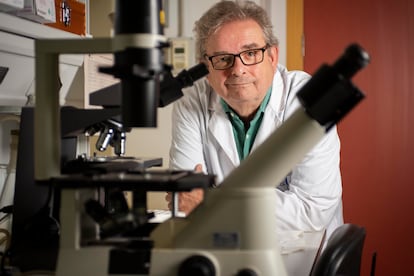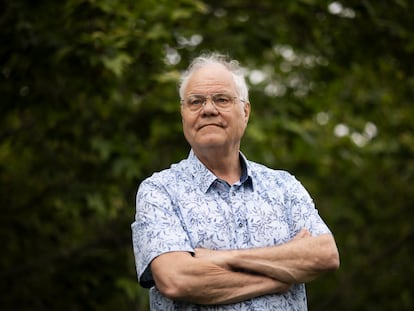Why isn’t gene therapy available to more patients? Blame millionaire prices and uncertainty as to its effectiveness
The arrival on the market of many innovative treatments has been hampered by pharmaceutical companies’ business strategies

Darius is 15 years old and is a dazzling example of how medical research has advanced. Born with a rare and lethal genetic disease, early active cerebral adrenoleukodystrophy — CALD, the same condition that killed his older brother Danuk — the adolescent boy is today, healthy and happy in his hometown of Quintanar de la Orden, in the Spanish province of Toledo. His recovery has been thanks to a gene therapy called Skysona. A benevolent virus, a Trojan horse that was introduced into his body when the boy was five years old, it was able to replace the boy’s defective gene with a healthy one, thus saving his life.
But to the frustration of his doctors and other families, Darius’s treatment has not been available on the European market since 2021, due to a decision made by its pharmaceutical company Bluebird Bio that has left dozens of young people in the EU without the opportunity to follow Darius down the same path to survival. “It is difficult to comprehend,” says Carmen Sever, president of the European Lecodystrophies Association in Spain (ELA-Spain), which has helped patient associations to finance and develop the drug.
Skysona’s complex relationship to the commercial market is no exception, but rather the norm when it comes to this kind of drug. Despite enormous expectations that have sprung up around them, of the 11 gene therapies for rare diseases that have been approved by the European Medicines Agency (EMA) since 2012, only two — Zolgensma and Luxturna, both from Novartis — have seen significant commercial deployment. The rest have failed due to various reasons, having been withdrawn due to business strategy or are still subject to a search for their economic viability.
“On some occasions, the problem is that there is simply no market as such, due to a limited number of patients, and that causes insurmountable financial challenges,” says Juan Oliva, a professor of economics at the University of Castilla-La Mancha. Libmeldy is another example of a gene therapy designed to treat a rare condition, metachromatic leukodystrophy, which affects only three children born each year in Oliva’s country of Spain. This results in pharmaceutical companies charging extravagant prices for its use. Libmeldy costs almost $4 million in the United States. Add to this hefty price tag the uncertainty that often surrounds the efficacy and safety of these therapies, and it’s easy to understand why so many patients hesitate in taking the financial plunge.
“They are such cutting-edge medications that sometimes the system itself is not prepared to take advantage of them,” says Aurora Pujol, a geneticist at the Institute of Bellvitge Biomedical Research (Idibell). She brings up the thorny issue of neonatal screening. “It is not widespread in many countries. Without it, it is not possible to identify babies with genetic conditions before they develop symptoms. And by then, it is too late for gene therapy to be effective. The system must adapt or many therapies will never make it off the ground,” she says.
The EMA approved its first gene therapy in 2012. That was Glyvera, a treatment for an ultra-rare hereditary ailment that affects less than one in a million people, and that prevents those affected from digesting fats. The excitement that its approval generated quickly dissipated when it became clear that the treatment was going to be a commercial failure. “Use of Glyvera has been extremely limited and we don’t foresee growing demand in coming years,” said Matt Kapusta, director of the pharmaceutical company uniQure, in a 2017 announcement that the drug would be pulled from the market.
Strimvelis, approved by the EMA in 2016, provides an even starker illustration of the havoc that concerns over a drug’s commercial viability can wreck on patient access. Indicated in the treatment of so-called “bubble children” — kids that suffer from severe combined immunodeficiency — pharmaceutical research on the drug began more than two decades ago at the San Raffaele university hospital in Milan. Subsequently, pharmaceutical giant GSK acquired the rights to Strimvelis, but due to its poor commercial prospects, the firm sold them in 2018 to Orchard Therapeutics (the same company that developed Libmeldy). After years of fruitless efforts to stimulate sales, the rights were transferred back to the Telethon Foundation of Gene Therapies of Milan, which is associated with the San Raffaele hospital.
This case has been presented as an example of the need to look for new formulas — sometimes, independently of the logic of the market — to develop treatments for rare diseases and guarantee access for patients. Francesca Pasinelli, general manager of the Telethon Foundation, confirmed last October that the group had acquired rights to Strimvelis: “We are taking on a large financial commitment, but we are able to do so because we are a non-profit organization. We just have to break even.” The drug will now be available to public health systems (and private insurance) in Europe and the rest of the world.

The problem with the ups and downs of the commercial drug market is that, when push comes to shove, patients’ ability to purchase medicine can be subject to dramatic delays. Eight years after it was approved by the EMA, Strimvelis had only been received by one young Spanish female patient. “She was treated in Milan for the first time in November 2022. We have followed her progress since then and can confidently say that her treatment has been a success and that she has been cured,” says Manuel Santamaría, a professor in clinical immunology and doctor at Córdoba’s Hospital Reina Sofía.
“The big pharmaceutical companies, in general, have abandoned this sector. The investment and development costs are very high and the chances of recovering that investment are uncertain,” says Pujol. This has led to small companies, eager to raise capital and, in so doing, offer high returns to investors, becoming the leaders in this particular market.
But on some occasions, these firms make shocking decisions, like that of Bluebird Bio in 2021. After disagreeing with the German government over the price of one of its drugs, it decided to close down its operations in Europe and concentrate on the U.S. market. In one fell swoop, EU patients were deprived of two promising gene therapies in Skysona and Zynteglo, the latter of which is indicated for a hereditary blood condition, beta thalassemia, which requires patients to undergo monthly blood transfusions. “I will never understand why, if the medicine that saved my son exists, other European children can’t also be cured,” says María Potirniche, Darius’s mother.
Bluebird Bio started selling both pharmaceuticals in the United States in 2022 at a price of $3 million and $2.8 million, respectively, making them the most expensive drugs in the world. But even in the neoliberal U.S. market, the drug has yet to be sold to 30 patients. The company’s fate on the stock market, a reflection of investor confidence, likewise has failed to shine: in 2018, its stocks were selling at $115 — by last Friday, they had fallen to 95 cents.
Orchard Therapeutics, the other company that has battled to lead in the development of gene therapies during the last five years, has followed a similar trajectory. It was trading above $200 in April 2019, then lost practically all its value and was finally acquired last year by the Japanese pharmaceutical company Kyowa Kirin. According to the company’s last reports before the acquisition, from back in 2022, Orchard earned only $20.2 million that year, the equivalent of eight sales of the drugs at their official price (though the figure could account for more, discounted sales.)
In any case, these numbers are far below expectations and serve as proof that the market has not been successful in getting the treatments it has developed to the patients who need them. PTC Therapeutics’s Upstaza, which was approved by the EMA in May 2022 and is indicated for protein deficiencies that can cause the nervous system to malfunction, has also failed to penetrate the market, according to the company’s annual report.
The reason for this, beyond Upstaza’s elevated price (official figures place it above $3.5 million per patient), is related to “the risks involved in the method of administration [a complex injection into the center of the brain] and uncertainties surrounding its safety and effectiveness,” according to a report from Spain’s Ministry of Health, factors that nonetheless must be put into perspective by a total “absence of treatment alternatives.”
Hemophilia has been one of the health conditions on which gene therapy has had the greatest impact, with two treatments approved by the EMA in 2022: Roctavian (developed by BioMarin to treat hemophilia A) and Hemgenix (CSL Behring’s drug designed to combat hemophilia B). They promise to allow patients to live for years — from three to 10, according to available research — free of the disease, without having to depend on coagulation. But the drugs’ high prices ($2.9 and $3.5 million, respectively) also present challenges to sales. The first European patient to receive Roctavian, for example, was an Italian who did not access the medication until last April.
“The problem with these prices is that, in the case of hemophilia, they means paying in advance for a large quantity for cases in which they are already accessing alternative treatments that allow for a high level of control of the illness, safely distributing the cost over time. In addition, when it comes to these situations, we must always keep in mind that we still know very little about the long-term safety of gene therapy,” says Vicente Arocas of the GÉNESIS drug evaluation group of the Spanish Society of Hospital Pharmacy (SEFH).
Last February, the EMA took a final qualitative leap with the approval of the first drug featuring the revolutionary CRISPR technique, which allows for the editing of human DNA. Vertex Pharmaceutical’s Casgevy is indicated for two blood conditions, thalassemia and sickle cell anemia. Its approval took place so recently that the drug has not yet reached the market, but its advancement does show that, despite all challenges, “there is no going backwards when it comes to gene therapies,” says Jaime Espín, professor at the Andalusian School of Public Health and former advisor to the World Bank and the European Commission.
“The last few years have been complicated, which is logical if we keep in mind that they have been ground-breaking in terms of science, but also in the commercial and regulatory sense. The first drugs, for example, were approved based on less robust evidence from the results of a handful of patients. That increases uncertainty about their safety and effectiveness, which in turn complicates their purchase as very expensive medications. My opinion is that we are headed towards a scenario with more solid results that is safer for all involved, which should help the dozens of drugs currently under development to have an easier landing in the market,” says Espín.
That opinion is shared by sources from Spain’s Ministry of Health who are close to the complex process of vetting these new drugs. Their ultimate goal is to reduce uncertainty when it comes to effectiveness and safety, but also when it comes to their economics. “And in that sense, new formulas, dialogue beginning in the early stages of development (long before EMA approval) between all parties, flexible agreements (as in payment according to results) and the sharing of real-life data will play important roles. Additionally, when it comes to the European Union, cooperation and even collaborative action between countries can be explored,” conclude these sources.
Sign up for our weekly newsletter to get more English-language news coverage from EL PAÍS USA Edition
Tu suscripción se está usando en otro dispositivo
¿Quieres añadir otro usuario a tu suscripción?
Si continúas leyendo en este dispositivo, no se podrá leer en el otro.
FlechaTu suscripción se está usando en otro dispositivo y solo puedes acceder a EL PAÍS desde un dispositivo a la vez.
Si quieres compartir tu cuenta, cambia tu suscripción a la modalidad Premium, así podrás añadir otro usuario. Cada uno accederá con su propia cuenta de email, lo que os permitirá personalizar vuestra experiencia en EL PAÍS.
¿Tienes una suscripción de empresa? Accede aquí para contratar más cuentas.
En el caso de no saber quién está usando tu cuenta, te recomendamos cambiar tu contraseña aquí.
Si decides continuar compartiendo tu cuenta, este mensaje se mostrará en tu dispositivo y en el de la otra persona que está usando tu cuenta de forma indefinida, afectando a tu experiencia de lectura. Puedes consultar aquí los términos y condiciones de la suscripción digital.
More information
Últimas noticias
‘Sleepless City’: The light of cinema illuminates Madrid’s Cañada Real shantytown
All the effects of gentrification in one corner of Mexico’s Colonia Roma
Palestinian reporter Youmna El Sayed: ‘My family told me I had to choose between being a journalist or a mother’
The new language of the workplace: Knowing how to ask AI questions is more important than using it
Most viewed
- Families demand repatriation of bodies of Colombians who died in Ukraine: ‘This war is a slaughterhouse for foreigners’
- The low-cost creative revolution: How technology is making art accessible to everyone
- Liset Menéndez de la Prida, neuroscientist: ‘It’s not normal to constantly seek pleasure; it’s important to be bored, to be calm’
- Christian Louboutin: ‘Young people don’t want to be like their parents. And if their parents wear sneakers, they’re going to look for something else’
- ‘El Limones’ and the growing union disguise of Mexican organized crime











































